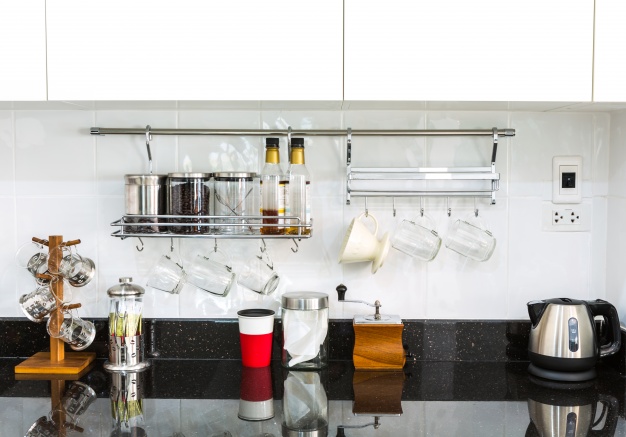Property prices have been rising but a lot of houses are still for sale, with few purchasers for them. To make yours stand out from the crowd follow these simple steps provided by Debbie Orme… top five elements to affect the cost of building your home.
Clutter be gone
When you put your house on the market the first step is a major de-clutter. Some vendors actually put most of their furniture in storage before viewings, but you don’t have to go to this extreme. The trick to ‘staging’ a house is to do it as tastefully as possible, but not to the point where even the candles are placed in order! Going
to these lengths can create a lack of homeliness and remove any atmosphere from it. A house must look ’lived in’.
Instead of getting stressed out at this stage, take the de-cluttering process as a chance to literally get your own house in order! Start by filling boxes for storage and plastic bags for charity shops weeks, or even months, in advance of advertising the sale.
Take on one area at a time. Be focused, objective and ruthless and try to follow these rules:
- In the hallway limit each person in the house to just one coat on show. Move the rest to wardrobes.
- Throw out all magazines and newspapers on view, or hide them!
- Limit the number of toys your children have lying around. Buy a toy box if you have no extra storage space.
- Keep your ornaments to a minimum. If you don’t want to throw them away, simply pack them for your move and store them in the attic.
Once you’ve finished de-cluttering, bring in a handyman to do all of those little jobs that have been on your ‘to do’ list for too long, such as repairing leaky taps, putting up shelves, or fixing broken masonry.
From the outside
It goes without saying that presentation is everything and most homebuyers are attracted to clean, spacious and attractive houses. Your goal is therefore to dazzle potential purchasers and you can begin this process even before they come in
the front door. Simple aesthetic improvements, such as trimming trees and planting flowers in the garden, fixing squeaking steps on the way in and replacing broken tiles will generate a positive first impression. You could also:
- sweep the paths
- mow the lawn
- prune any bushes
- weed the garden
- clean debris from the garden and path
Gardens are becoming increasingly important to house buyers as a potential extension of the living space for the summer months. In addition to the basics already listed, you can also set the scene with garden furniture, patio heaters and lush planters. You can then take these items with you when moving, so don’t worry that the buyer will
get the benefit.
Patio and decking will appeal to many busy people. Not only do they smarten up the outside, but they don’t require much maintenance, so you will have created another selling feature.
One small, but really significant, point – make sure that your doorbell works! Otherwise you might not hear your buyers and they’ll not be too amused at having to stand on the doorstep hammering on the door.
In summary, the exterior of the house should be welcoming and create a desire within the viewer to see the interior.

Don’t let them be a pane!
Repair any broken or cracked panes of glass and, if they are single-glazed, consider whether spending £2,000-£3,000 on double glazing would be a good investment. Clean them thoroughly (both inside and out) and ensure that any surrounding paintwork is not flaking.
House buyers are often impressed by natural light and a sense of space, so do whatever is necessary to maximise these in your home. Window dressings are very important, but remember that the primary function of windows is to let light in. If
the view from your windows is, however, not very inspiring, the clever use of blinds or voiles can make a virtue out of a necessity and not sacrifice too much light.
Continuing this theme, don’t clutter window sills or position furniture where it will block the light. A mirror on the wall opposite a window not only increases the light, it also gives a greater sense of space to the room.
Insider info
Once inside, make sure that your visitor is greeted by a neat and tidy interior. 75% of the work of house doctors is usually in ‘dressing’ rather than major alterations. You don’t want to spend a fortune on getting a house ready to sell, but the odd £500-
£1,000 (€600-€1,200) spent on repairs, paint and perhaps a few ‘hide-all’ pieces of furniture could prove to be money well-spent. As a general rule of thumb, take the following on board:
- Clean and spruce up all rooms; furnishings, floors, walls and ceilings. It’s especially important that the bathroom and kitchen are spotless.
- Even if it’s not part of your usual routine, tidy up the interiors of your wardrobes and other pieces of furniture. Human nature is such that buyers will not hesitate to look in places you think they won’t so make sure they’re left with a good impression.
- Make sure that appliances and fixtures work, fix leaky taps.
- Plants and flowers will add life and colour to a room, but only if they are alive and vibrant.
Discard any plants that are looking less than healthy, take advice from a garden centre on what to replace them with.
No matter how house proud you are, there’s nearly always more to be done before admitting potential purchasers. A thorough tidy, especially of tables and floors, is a good place to start, then give the rest of the house a dust, vacuum and polish to
have it sparkling from top to bottom.
Grubby paintwork leaves a particularly bad impression. If it’s chipped or just faded, a quick lick of paint will transform it, and as a consequence the look of your house as well. Remember that natural muted and neutral colours will tend to appeal to
more viewers than the current trend for vibrant, dynamic ones. Although paint schemes can be easily changed, you don’t want to deter a potential buyer who can’t see past the fuchsia and lime green walls in the bedroom!
Bathrooms and kitchens
Both of these rooms are critical in the selling stakes. Understated but stylish are the
watchwords so make sure they’re really clean with fresh towels and, if the suite is best
replaced, white is the best option with modern chrome fittings.
Power showers are a good investment, while having no shower at all is likely to detract from the value of a property.
Tiling your bathroom from floor to ceiling will create the illusion of space and height and will appeal to those looking for a low-maintenance interior.
Minimalist storage cabinets conceal toiletries and keep bathrooms neat and clutter free.
Turning to the kitchen, if you feel that your units are tired, damaged or just old-fashioned, then simply replace the doors cheaply and cheerfully. DIY shops can provide white, country-style doors at a fraction of the price of a whole new kitchen.
Small changes such as these can create the appearance of a new one.

Eau de Chat…?
With all of the furniture and furnishings sorted, it’s time to turn your attention to how the house smells. Take a lead from the supermarkets whose research found that the aroma of baking bread or brewing coffee encouraged shoppers to stay longer and buy
more! Even if you can’t go to these lengths, avoid the smell from wet washing, animals and anything else not universally attractive. Whether it’s pot pourri, freshly-cut flowers or brewing coffee, make sure that the first fragrance your visitor gets wind of
is one they’ll recall with pleasure.
Second opinion
Once you think you’ve done everything and it’s ready for viewing, invite a second opinion from a neighbour. Ask them to walk through your house as if they were a buyer; a fresh, independent eye will give you an honest opinion and your neighbour
will spot things that have escaped your notice. Take their opinion on board; if they think that the stuffed donkey in the living room needs to be ‘relocated’ for a while, move it!
Buyer beware
Always remember that you are allowing strangers into your home, the National
Association of Estate Agents says that the average number of viewings per sale is twelve. Be sure therefore to have all the details about the viewer from the estate agent before they arrive, and ask the viewer to confirm these upon arrival. If you’re
going to be on your own, get a neighbour or friend in to keep you company. Exercise caution when giving personal information or details about times when you’re likely not to be at home – burglars come in many guises!
Extra tips From Carol Tallon of Buyer’s Broker
1. Avoid the temptation to ‘test the market’. It’s a bad idea to let the estate agent and viewers in prematurely, with the intention of carrying out upgrades only if they are needed. The truth is, you and your house only have one opportunity to impress. Buyers will not reconsider a property they have already ruled out just because you have done some work. This is particularly true in the current market.
2. Following on from the point above, if your property has already been on the market for longer than the local average and is failing to attract attention from house-hunters, the best option is to take down the For Sale sign, withdraw the listing from property websites and carry out the upgrades required. Once that is done, relaunch it on the market with new images and a fresh description and most importantly, a realistic asking price. First impressions of your home are hugely important and they’re nowadays generally formed after viewing the on-line listing. Flattering – but still accurate – photographs are therefore crucial.
3. This tip is a controversial one: pay the estate agent enough to motivate them! I am not an estate agent nor have I ever been but I understand the industry well enough to know that most of them have more properties than buyers. After all, we’re in a recovery marketplace. Many times sellers boast about negotiating estate agency fees to very low levels and then they are surprised when the property fails to sell quickly. As a seller, you need to ensure that yours is the first house presented to suitable buyers. It helps to remember that time has an opportunity cost attached. In fact, I am aware of regular sellers who pay the estate agents a bonus if the property sells at an agreed minimum price within the first month. This strategy is not for everyone but if you have a self-build project ready to go, you may want to consider it to make the process run a little more smoothly.







